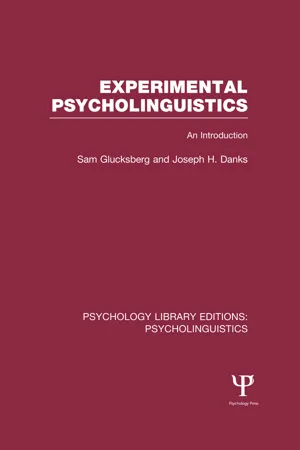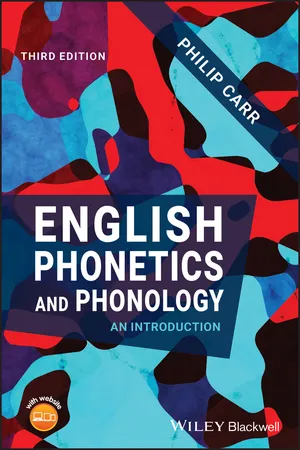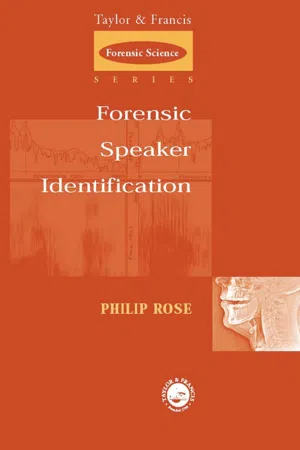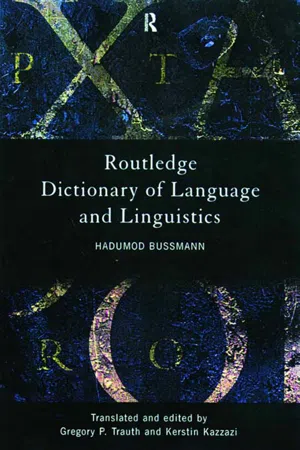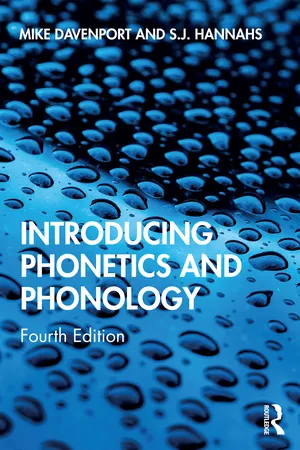Languages & Linguistics
Phoneme
A phoneme is the smallest unit of sound in a language that can distinguish one word from another. It represents a set of speech sounds that are perceived as the same by speakers of a language. For example, the "p" and "b" sounds in English are considered separate phonemes because they can change the meaning of a word, such as "pat" and "bat."
Written by Perlego with AI-assistance
Related key terms
10 Key excerpts on "Phoneme"
- eBook - ePub
- Bruce M. Rowe, Diane P. Levine(Authors)
- 2022(Publication Date)
- Routledge(Publisher)
In reality, in spoken language, a Phoneme is a class of sounds or phones that speakers and listeners perceive as being one sound. The Phonemes /b/ and /p/ have no meaning in themselves. Yet words that are the same except for a difference of one Phoneme (in the same position in each word) contrast. That is, they have different meanings (e.g., bit and pit). The word perceived is used earlier in this paragraph because, as mentioned previously, a Phoneme is a mental construct that tells a listener that two or more sounds function as the same sound or different sounds, regardless of the acoustic properties of the sound. For example, [p] and [p h ] are acoustically (physically) somewhat different sounds, yet native English speakers (who have not taken a linguistics class) perceive them as being the same sound. Therefore, native speakers would call them both the p sound. The word Phoneme comes from the Greek root meaning sound. Yet Phonemes are not sounds. A Phoneme is a mental construct. No one has ever heard a Phoneme. In the case of /p/, the listener hears either [p] or [p h ] or various other allophones of /p/ that we have not discussed. The unit /p/ exists in the mind of the speaker and listener. The /p/ and all other Phonemes are organizational and functional units with no physical properties of their own. Not only is a Phoneme not a sound, but it also does not have to refer to sound. Phonemes exist in soundless languages such as American Sign Language (ASL). We discuss the Phonemes of ASL in Chapter 11. Sounds such as [p] and [p h ], which are allophones of the same Phoneme /p/ in English, might be different (separate) Phonemes in another language. For example, in Hindi the aspirated [p h ] sound and the unaspirated [p] sound are different Phonemes. In Hindi, [kapi] means copy, whereas [kap h i] means ample. This difference in meaning between words that are identical except for aspiration is consistent in Hindi - eBook - ePub
Experimental Psycholinguistics (PLE: Psycholinguistics)
An Introduction
- Sam Glucksberg, Joseph H. Danks(Authors)
- 2013(Publication Date)
- Psychology Press(Publisher)
Categorization. Third, all units of speech are members of categories, and we perceive them as such. Whenever we use a word, we symbolize a category of events, things, or relationships. At the level of speech sounds a unit of sound itself, the Phoneme, is really a category of speech sounds that are functionally equivalent. Our ability to discriminate between categories is extremely good; our ability to discriminate among members within the same category is quite poor. This principle is clearly demonstrated in speech perception, and is also applicable to our perception and interpretation of larger speech units.In this chapter we refer to each of these three general principles of language behavior in the context of the sound system of English and the facts and theories of speech perception. We shall see later that these three principles apply with equal force to word, sentence, and message processing.Sounds and PhonemesEvery human language has a relatively small set of sounds that is unique to that language. Languages sound different from one another, but the differences we hear are not caused by different orderings or sequences of the same set of speech sounds. Instead, different languages use different sets of sounds, each set consisting of a relatively small number of Phonemes. A Phoneme is defined as the smallest unit in a language that makes a meaningful difference to people who speak that language. Listen to the initial sounds of the words bad and pad. The only difference between them is in their first sound. Since this difference in the initial sounds produces two different words, the difference is a meaningful one. This meaningful difference, OF contrast, defines /b/ and /p/1 as two different Phonemes. Similarly, bad and bid are two different words. Hence, the difference between /æ/ and /I / is a meaningful difference, and so /æ/ and /I / are two different Phonemes, as well. Finally, one can contrast bad and bat to discover that /d/ and /t/ are also two different Phonemes. Two speech sounds are defined as different Phonemes if, when one is substituted for the other in a word, the result is two different meaningful words.Why do we take so much trouble to define phonemic differences? Why can’t we simply say that two speech sounds are different if they sound different? The problem here is that people who speak different languages perceive the speech sounds differently. Two speech sounds that sound very different to people who speak English may not sound different to people who do not speak English. We clearly hear the difference between rice and rise and between ice and eyes - David Hornsby(Author)
- 2014(Publication Date)
- Teach Yourself(Publisher)
Laying the foundations: sound systems in languageWhile the phonetician studies the articulatory, auditory or acoustic properties of speech sounds, the phonologist’s task is to understand how these sounds are organized in languages. In any language, a relatively small number of contrastive speech units, known as Phonemes, are responsible for distinguishing all real and potential words, and native speakers quickly learn which distinctions matter for this purpose and which do not; they are also aware of the rules by which these Phonemes may or may not be combined. In this chapter, we will look in detail at the concept of the Phoneme, and consider some tests by which they may be identified.Phonemes and allophonesTwo speakers of the same language may have slightly different Phoneme inventories, or they may use the same set of Phonemes in different ways. We will learn how we as speakers recognize these accent differences, and how phonologists attempt to model what speakers unconsciously ‘know’ about the sound system of their mother tongue. We will also consider syllable structure, which proves a very important factor in determining how the sounds of a language are organized.If two native English speakers were asked to say the sequence [bat] ten times, it is likely that none of their [b] s, [a] s or [t] s would sound exactly the same, but a third English speaker would nonetheless understand the same word, bat, every time. This is because speakers quickly learn to distinguish the differences that matter in their language from those that do not. An English-speaking child will very soon learn when a [p] sound, if voiced, may become a [b] and that this difference is important because pull and bull, pat and bat, path and bath and so on mean different things. And if the voicing distinction is important for [p] /[b] , then it is likely also to be important for [k] /[g] , [t] /[d]- eBook - ePub
Applying Linguistics in the Classroom
A Sociocultural Approach
- Aria Razfar, Joseph C. Rumenapp(Authors)
- 2013(Publication Date)
- Routledge(Publisher)
If we look back at the IPA chart of sounds we can see that there are numerous sounds. Each has a very specific description of how it is formed. In all languages some sounds may be produced in speech, but may not exist from the viewpoint of the speaker. A speaker, unless trained in linguistics, would not be able to speak the “linguistic” language about these, although, implicitly the speaker has a sense of different sounds. This distinction of the physical qualities of the sounds (phonetics) and the sound the language user believes to be there (a Phoneme) is an important distinction. The goal of this chapter is that you will be able to talk about these distinctions and use it to inform your teaching, and as you will see in the case studies, teachers that did this were able to develop a deeper understanding of their students.In linguistic talk, a “Phoneme” is a group of sounds that speakers of that language recognize as basically one sound. Prior to literacy, this isn’t really a necessary point. It isn’t until we have to start thinking about representing these sounds that we must understand what sounds are phonemic. Refer back to the IPA chart and notice that in the alveolar column there are many different sounds that can be created (e.g., [t], [d], [ɾ ], [n], [s]). More sounds may be indicated in the IPA that have different features, such as aspiration ([th ]). They all share the same place of articulation, and these that have been mentioned are all used in English, but some of them are not recognized once English is written. Look at the following list of words in Figure 3.2 that have been transcribed with the IPA. Try to pronounce them and jot down the word in English.Figure 3.2Allophones of the English Phoneme /t/Notice how your writing of the words compares to the phonetic transcription. The phonetic analysis tells us what physical qualities of the sounds exist, but that probably isn’t useful for helping students to learn English. When you wrote down the words, you should have noticed that the letter “t” is in every one of these words, yet the physical [t] sound is not. This is because the Phoneme /t/ is actually made up of several different sounds, called allophones. Allophones are all the sounds in a language that speakers consider as one Phoneme. The crux of phonological analysis is to be able to identify these Phonemes and to explain the “rules” they follow. Looking at the example above, when do you see the [th ] sound? How about the [ɾ ]? The [t] sound? Chances are when you are speaking or writing you don’t even notice that these are different sounds. It would be very difficult for an English speaker to correctly pronounce [‘sth - eBook - ePub
English Phonetics and Phonology
An Introduction
- Philip Carr(Author)
- 2019(Publication Date)
- Wiley-Blackwell(Publisher)
5 The Phonemic Principle5.1 Introduction: Linguistic Knowledge
We have been dealing, thus far, with phonetics, that is (as we have defined it), with the study of human speech sounds (although we have dealt exclusively with English phonetics, and in particular, exclusively articulatory phonetics, ignoring important facts about the acoustic properties of the speech sounds we have been discussing). We will, henceforth, be dealing with phonology, as well as phonetics. Phonology, we will claim, is to do with something more than properties of human speech sounds per se. Phonology is the study of certain sorts of mental organization. In particular, it is the study of certain types of mental category, mentally stored representations, and generalizations concerning those categories and representations. On this view, phonology is not the study of human speech sounds per se, although phonetics and phonology are inextricably intertwined. The point of this chapter is to demonstrate what the difference between the two is, and to begin to introduce the reader to the phonology of English. Let us begin by considering some general questions concerning what it is to know a language.Let us assume that when we say that someone knows a language, in the sense of being a native speaker of that language, he or she is in a certain mental state, or possesses a certain sort of linguistic knowledge. Knowledge of a native language is, apparently, largely unconscious knowledge. It appears to contain semantic knowledge (to do with the meanings of words, phrases and sentences) and syntactic knowledge (to do with the syntactic categories of words, with the structure of phrases and sentences and with the syntactic relations between words, phrases and clauses). We know that this is so, since speakers are able to make syntactic and semantic judgements, based on that knowledge. For instance, a native speaker of English can judge that Who did you see Graham with? is an English sentence, and that Who did you see Graham and? is not. The speaker knows, again intuitively, that the difference between the two amounts to more than the difference between the mere presence of the word and as opposed to the presence of the word with. He or she also knows intuitively (not necessarily fully consciously) in what sense He told the man who he knew is ambiguous, and in what sense the two interpretations of that sequence of words differs in structure and meaning from He told the man how he knew, over and above the superficial fact that one sequence contains who and the other how. That knowledge is clearly unconscious knowledge, since we require no instruction to be able to make such judgements, and we can make them in the absence of any conscious knowledge whatsoever of the syntax and semantics of English (one could make such judgements even if one had not the faintest idea of what a noun or a verb might be, or what the syntactic categories of with, and, who and how - eBook - ePub
Speech to Print
Language Essentials for Teachers
- Louisa Cook Moats(Author)
- 2020(Publication Date)
- Brookes Publishing(Publisher)
phonology refers to the sound patterns of language and to the discipline of studying these sound patterns and their mental representations.The previous chapter on phonetics describes and classifies the inventory of speech sounds in English. Within a phonological system, however, speech sounds are not randomly ordered and combined. A phonological system allows only certain sequences of Phonemes in the inventory to be combined. In English we can say [daks] but not [dksa]. The Swahili names Mzee and NgoroNgoro are not possible in English. Many such constraints are part of the phonological layer of language.Constraints on Phoneme SequencesWhen a teacher plays Hangman or does a crossword with a class of children who already know something about spelling, some students will make logical guesses about the letter sequences in words and some will not. The children who make logical guesses not only are better at keeping track of which letters have been asked already, but also have a better sense of the order in which sounds and letters occur in words. They realize, often intuitively, that words in their language are formed from certain permissible sequences of Phonemes. These possibilities are influenced by ease of pronunciation, but frequently, the sequences are arbitrary and simply part of the grammar of the language.Suppose that you were asked to create possible or pronounceable words in English using only these four Phonemes: /b/ /l/ /ŋ/ /ɛ/.The only sequence that would be possible is [b l ɛ ŋ]. No words in English can start with /ŋ/; no blends start with /l/; no beginning blends have /ŋ/ as the second Phoneme; and there is no sequence [ŋb] or [bŋ] in English syllables. So, the only pronounceable option is [bl] in the beginning, with [ɛ] and [ŋ] following.When words begin with an affricate, a liquid, a glide, or a nasal, the next sound must be a vowel. In English, we cannot create words such as yburtz, lgas, or chwot for this reason. There can be no more than three consonant sounds at the beginning of a word, but words with three consonant sounds at the beginning are limited to the following possibilities in first, second, and third position: [s] + [p, t, k] + [l, r, w, y]. Thus, we have the words sprain [spren], strain [stren], square [skwer], and spew [spyu] beginning with these three-consonant sequences. Not all sequences of these elements are possible, however; we can say the word strict but not the word stlict. - eBook - ePub
- Phil Rose(Author)
- 2002(Publication Date)
- CRC Press(Publisher)
7 Phonemics
Speech sounds in individual languages
The preceding chapter introduced the general speech-sound producing capabilities of humans. It was intended to give a brief answer to the question: what is the articulatory nature of the speech sounds that humans use?However, forensic phonetics does not look at speech sounds context-free, as in the previous chapter, but as they occur in the speech of someone speaking a particular language. There is a profound difference between these two ways of looking at speech sounds. It is a fact of the structure of Language that speech sounds operate on two different levels, and because of this dual structure it is not enough, indeed it is not possible, to describe the similarities and differences between two or more samples of speech in terms of the articulatory (or perceptual) nature of the sounds alone: to say, for example, that sample A has such and such an inventory of sounds compared with sample B.The two different levels at which speech sounds exist are called the phonetic level and the phonemic level, and the difference between them is often called the etic-emic difference. The former, phonetic level, has been covered in Chapter 6: it describes speech sounds tout court, without reference to a particular language. The latter, phonemics, can be seen as a conceptual framework within which to describe the sounds of a given language, or dialect. It is thus language-specific, although its analytical principles are supposed to be applicable to all languages. This chapter introduces those principles. It describes how forensic phoneticians, and indeed most descriptive linguists (linguists who have to do with the description of languages), conceptualise the structure of the sound component of Language. It also describes how speakers can differ in phonemic structure.Most introductory textbooks on linguistics or phonetics, for example Fromkin et al. (1999: 247–69), Crowley et al. (1995: 48–114), Finegan et al. - eBook - ePub
- Hadumod Bussmann, Kerstin Kazzazi, Gregory Trauth(Authors)
- 2006(Publication Date)
- Routledge(Publisher)
prosody, while in American linguistics phonology is occasionally used as an umbrella term for phonetics and phonemics.(a) Structuralist phonology: structurally oriented phonology started with N.Trubetzkoy (⇒ Prague School) and quickly developed in several directions. While Trubetzkoy was concerned with the functional aspect of phonemic analysis, the principle of the opposition of Phonemes as the basis of his phonological work, American structuralism bases its concept of Phoneme largely on distributional criteria (see Bloomfield 1933; Harris 1951). Common to both varieties is the way in which phonology is understood as an autonomous level of linguistic description in contrast to generative phonology (see Chomsky & Halle 1968, among others). Phonology is considered a basic discipline of structuralist language analysis (⇒ operational procedure). This is particularly the case for the functional principle of distinctiveness (⇒ distinctive feature, opposition), the analytical process of segmentation and classification, but especially for the concept of the Phoneme as a bundle of distinctive features and for the hypothesis of a universal inventory of phonological features as the basis for describing all languages of the world (see Jakobson & Halle 1956).(b) Generative phonology: in contrast to the structuralist interpretation of phonology as an autonomous level of linguistic description, in the framework of generative grammar, phonology refers to phonetic, phonological, and syntactic-morphological regularities (=systematic phonology). Instead of the Phoneme, distinctive features of a universal character are considered the basic units of the phonological description (⇒ distinctive feature theory). On the basis of relatively abstract and stable underlying forms, the phonetic variants of the surface structure are derived from extrinsically ordered rules (cf. as the underlying form - eBook - ePub
- Mike Davenport, S.J. Hannahs(Authors)
- 2020(Publication Date)
- Routledge(Publisher)
h ] word-initially, as the allophone [p] in an initial cluster following [s] and as the allophone [p˺] at the end of a word. The relationship can be shown graphically as in (8.3).- (8.3)
Viewing speech sounds this way enables us to distinguish systematically between underlying representations and sounds actually occurring in a language. This, in turn, allows us to establish the relatively small inventory of underlying Phonemes of a language and relate them to the greater number of sounds that speakers of that language actually produce. By looking at the speech sounds of a language in this way we start to see the underlying system. Coming back to a point made in Chapter 1 , phonologists are interested in the patternings, or systematic relationships, of speech sounds in human languages. The Phoneme/allophone distinction enables us to see patterns in the distribution of speech sounds in an insightful way and in a way we could not see simply by listing all of the speech sounds of a given language.Knowing, for instance, that English contains [b], [p], [ph ] and [p˺] – a list – tells us nothing about any possible phonological relationships between these sounds, that is that [p], [ph ] and [p˺] are allophones of a single Phoneme, /p/, and that [b] is an allophone of a contrasting Phoneme, /b/.It is important to recognise that this kind of abstraction from the concrete to the underlying is not unique to linguistics and is, in fact, a familiar concept from the natural sciences. Consider water. We all know certain facts about water. First of all, we know that, abstractly, it is composed of two hydrogen molecules and an oxygen molecule, which we represent formally as H2 O. We also know that at a temperature below 0°C H2 O appears as ice; between 0°C and 100°C H2 O appears as liquid water, and above 100°C H2 O appears as water vapour. Just as the p-sounds [p], [ph ] and [p˺] are underlyingly /p/, water, ice and water vapour are underlyingly H2 O.- (8.4)
What this means is that in both cases, the phonological and the physical, we have a single underlying entity – i.e. /p/ and H2 O, respectively – that occurs in differing forms depending on the specific environment. If we chose not to view phonology in this way we would be forced to say that [p], [ph ] and [p˺] are not related to a single abstract entity and therefore to each other, which would be analogous to saying that water, ice and water vapour are not related to H2 - eBook - ePub
- Ali Almanna, Juliane House(Authors)
- 2023(Publication Date)
- Routledge(Publisher)
2 Phonetics and phonologyDOI: 10.4324/9781003228028-3This chapter is an introduction to phonetics, phonology, and the main differences between them. It also familiarizes you with the main branches of phonetics, such as ‘articulatory phonetics’, ‘acoustic phonetics’, and ‘auditory phonetics’. Further, the main stages of sound production, such as ‘respiration’, ‘phonation’, ‘oro-nasal process’, and ‘articulation’ are explained in this chapter. Added to this, phonological features are discussed in a direct link to translation.After studying this chapter, you should be able to (1) define phones, Phonemes, and allophones; (2) identify vowel and consonant sounds in English; (3) identify the place of articulation and manner of articulation; (4) describe voiced and voiceless consonants; (5) distinguish simple vowels from diphthongs; and (6) assess the phonological features that should be reflected while translating between languages.What is the difference between ‘phonetics’ and ‘phonology’?Phonetics and phonology (from the word ‘phone’, meaning ‘sound’) are the branches of linguistics that study sounds but from different perspectives (for more details, see Ladefoged and Johnson 2010 ). While phonology focuses on how sounds function in relation to each other in a certain language, phonetics concentrates on how sounds are produced by speakers’ vocal apparatus, transmitted by atmospheric air, and perceived by listeners’ auditory system. It thus provides “methods for their description, classification, and transcription” (Crystal 1980/2008
Index pages curate the most relevant extracts from our library of academic textbooks. They’ve been created using an in-house natural language model (NLM), each adding context and meaning to key research topics.

